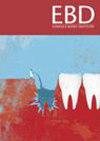我们有足够的证据推荐羟基磷灰石牙膏预防龋齿吗?
Q3 Dentistry
引用次数: 0
摘要
Pawinska M, Paszynska E, Amaechi B T, Meyer F, Enax J, Limeback H。羟基磷灰石预防龋病的临床证据:最新的系统评价和荟萃分析。[J] Dent 2024;https://doi.org/10.1016/j.jdent.2024.105429 .数据来源:本综述的检索策略旨在找到羟基磷灰石被用作预防龋齿干预剂的已发表文章,与氟化物产品、安慰剂或无干预等主动对照进行比较。为此,作者使用了表示各种PICOS框架元素的关键字组合。检索在各种电子数据库中进行,包括Pubmed, Embase, Scopus, Web of Science和b谷歌Scholar。研究选择:本综述包括临床试验和原位研究。从检索中共检索到1245篇文章,但由于不符合纳入/排除标准,删除了1227篇文章。共纳入18篇文章,包括临床试验和原位研究。数据提取和综合:所有纳入的文章在纳入meta分析之前,均采用NHLBI标准进行质量评估。临床试验的结果测量主要包括龋发病率,记录为dmft(s)/ dmft(s)或使用ICDAS标准,而原位研究的结果测量数据包括不同的替代标记物。结果:对纳入的临床试验进行的荟萃分析显示,与安慰剂牙膏相比,HAP牙膏在预防龋齿方面明显更好(合并OR = 2.51)。与含氟牙膏相比,结果也更有利于含氟牙膏(合并OR = 1.1),但结果不显著。在原位研究中,也获得了显著的结果,在病变深度(总体平均变化1.15µm)和细菌负荷(总体平均减少65%)方面有利于HAP牙膏,而在再矿化方面获得了不显著的结果,有利于HAP牙膏(总体平均变化2.8%)。结论:HAP牙膏具有良好的防龋效果,可作为氟化物的良好替代品。本文章由计算机程序翻译,如有差异,请以英文原文为准。
Do we have enough evidence to recommend hydroxyapatite toothpaste for preventing dental caries?
Pawinska M, Paszynska E, Amaechi B T, Meyer F, Enax J, Limeback H Clinical evidence of caries prevention by hydroxyapatite: an updated systematic review and meta-analysis. J Dent 2024; https://doi.org/10.1016/j.jdent.2024.105429 . The search strategy for this review aimed at finding the published articles in which hydroxyapatite has been used as an intervention agent for caries prevention, compared with either active control like fluoride-products, placebo, or no interventions. For this, authors used a combination of keywords indicative of various PICOS framework elements. The search was carried out in various electronic databases, including Pubmed, Embase, Scopus, Web of Science, and Google Scholar. Both clinical trials and in-situ studies were included in this review. A total of 1245 articles were retrieved from the search, but 1227 articles were removed as they did not meet the inclusion/exclusion criteria. A total of 18 articles, including clinical trials and in-situ studies, were included in the review. All the included articles were assessed for quality using NHLBI criteria before including them in the meta-analysis. The outcome measures from the clinical trials mainly included the caries incidence, recorded as dmft(s)/DMFT(S) or using ICDAS criteria, while the data for outcome measures from in-situ studies included different surrogate markers. The meta-analysis done for the included clinical trials depicted HAP toothpastes to be significantly better for caries prevention when compared with the placebo toothpastes (pooled OR = 2.51). The results also favored HAP toothpaste when compared with fluoride toothpaste (pooled OR = 1.1) but the results were non-significant. For in-situ studies too, significant results were obtained, favouring HAP toothpaste in terms of lesion depth (overall mean change of 1.15 µm) and bacterial loads (overall mean reduction of 65%), while non-significant results, favouring HAP, were obtained in terms of remineralization (overall mean change of 2.8%). HAP toothpastes are found to be effective in preventing caries and can be considered as good alternative for fluoride.
求助全文
通过发布文献求助,成功后即可免费获取论文全文。
去求助
来源期刊

Evidence-based dentistry
Dentistry-Dentistry (all)
CiteScore
2.50
自引率
0.00%
发文量
77
期刊介绍:
Evidence-Based Dentistry delivers the best available evidence on the latest developments in oral health. We evaluate the evidence and provide guidance concerning the value of the author''s conclusions. We keep dentistry up to date with new approaches, exploring a wide range of the latest developments through an accessible expert commentary. Original papers and relevant publications are condensed into digestible summaries, drawing attention to the current methods and findings. We are a central resource for the most cutting edge and relevant issues concerning the evidence-based approach in dentistry today. Evidence-Based Dentistry is published by Springer Nature on behalf of the British Dental Association.
 求助内容:
求助内容: 应助结果提醒方式:
应助结果提醒方式:


